
This is Imelda, a charming Purépecha child already learning the traditional kitchen skills used by the ancestral generations of women on whose shoulders she stands. Morelia, Michoacán, 2012.
Today, more than 120,000 Purépecha live in 16 municipalities in the Zona Lacustre (Lake Zone) and the Meseta Purépecha (Purépecha tableland) of Michoacán. Within those municipalites are numerous towns and villages. Most Purépecha are bilingual. Generally the language spoken by the family at home is Purépecha. Children learn Spanish when they are part-way through primary school. There are still approximately 10,000 Purépecha who speak only their native language.
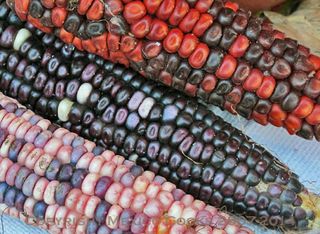
Maíz criollo (native Mexican corn) in three colors, grown for personal use in a Purépecha family's garden.
The present-day economy of the Purépecha is based, for the most part, in agriculture. The Purépecha grow corn for their own use and grow wheat to sell. In the Zona Lacustre, there are also a number of people who fish commercially.
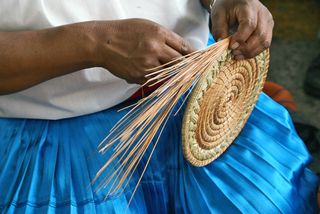
Making the fragrant base for a pine needle basket. Uruapan, 2010.
Another significant source of income is the creation of arts and crafts. In the mid-16th century, Don Vasco de Quiroga taught the Purépecha not only Christianity but also the idea of self-sufficiency based on the refined production of items for daily use: pottery, textile weaving, copper smelting, and wood carving. Approximately 40,000 families in Michoacán presently work at one form or another of artesanía.
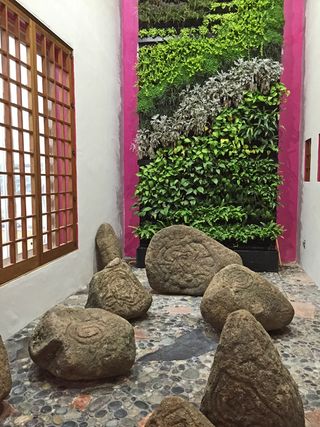
Eleven-hundred-year-old petroglyphs from Tzintzuntzan have a new home (with the approval of INAH, the Instituo Nacional de Arquitectura e Historia) in a visible but untouchable space in a Morelia, Michoacán gallery. It is believed that these and other Michoacán petroglyphs have spiritual and religious meaning that we cannot yet guess.
The ancient Purépecha believed that the Universe was divided into three parts: the region of the heavens, the region of the Earth, and the region of the dead. Each region had its own set of gods. The most important gods were those of the first region–the heavens–and among those, the most important were Kuerajperi, the Lord of Light, and Xaratanga, the goddess of the moon.
Today, the Purépecha practice a Catholicism colored by their reinterpretation of the teachings of the early Franciscan and Dominican missionaries. Many Purépecha believe that God, the Virgin Mary, Jesus, and the saints have special powers which interact among them. The devil, in some of his manifestations, has an importance which goes beyond that of the saints.

Many Purépecha continue to live in small villages, in some respects isolated from cultures other than their own. Their homes, called trojes, are made of heavy, hand-hewn thick pine boards. Each room of a troje is separate from every other room. The buildings are constructed without nails and can be dismantled and moved. The kitchen, living quarters, sleeping and storage rooms are individual small buildings such as the one in the photo to the right.
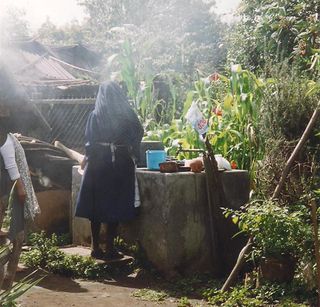
A close Purépecha friend, Débora Cortés, who has passed away since I took this photo, washed dishes in an outdoor pila (combination water storage basin, sink, and scrub board). The pila is the only source of running water for the household. Her bathroom was an outdoor toilet. She warmed water for bathing in buckets placed in the afternoon sun. My friend was fortunate to have a township water source rather than face the daily necessity of hauling water from a well. Note the roof of the troje at the upper left of the photo and the stalks of corn at right center. The greenery closest to the foreground is a coffee tree. Débora usually kept a pig in the garden, to raise for market and for meat. Mexico Cooks! photo, 2002.
Life for the Purépecha today is a battle for survival, both economic and cultural. Physical survival depends on many factors, including money sent home by the sons and daughters of the pueblos who now work in Morelia (the Michoacán state capital), Guadalajara, Mexico City, and in the United States.

The design on this troje is made with old music CDs. Pre-conquest Mexico, meet the 21st century. Angahuan, Michoacán, 2013.
Cultural survival is constantly assaulted by the influences of television, print advertising, and innovations brought home by the sons and daughters who work 'away'.
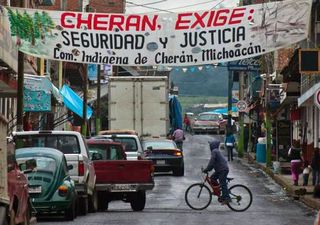
Cherán, an indigenous Purépecha community in the west-central part of Michoacán, is well known for its high level of political awareness and activity. The banner in the photo reads, "CHERÁN DEMANDS SECURITY AND JUSTICE" and is signed, "The indigenous community of Cherán".
Political survival is crucial to the continuation of the Purhépecha nation. In Cherán, Michoacán (pictured above), the Purépecha community holds its own community elections and does not subscribe to state and national elections.
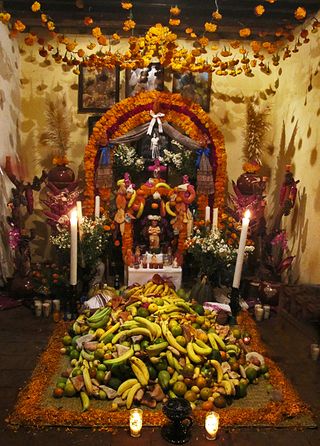
Night of the Dead altar dedicated to a deceased relative, private home, Santa Fe de la Laguna, November 2013. The Purépecha tradition of spiritual and religious practices combines ancient rituals and customs with Roman Catholic beliefs. The amalgam sustains and nourishes a community which is itself a combination of the ancient and the modern.
Spiritual survival depends on the handing down of the old ways, the old traditions, by a generation of elders that is fast disappearing. The question of globalization in indigenous communities is not an idle one, but one which must be addressed if the Purépecha are to survive as more than a curiosity in the modern world.
Next week we'll make our final stop (for now!) in the Purépecha towns of Michoacán, in which a delightful visit to Santa Fe de La Laguna turns into a language lesson! Come with us!
Looking for a tailored-to-your-interests specialized tour in Mexico? Click here: Tours.
Leave a Reply